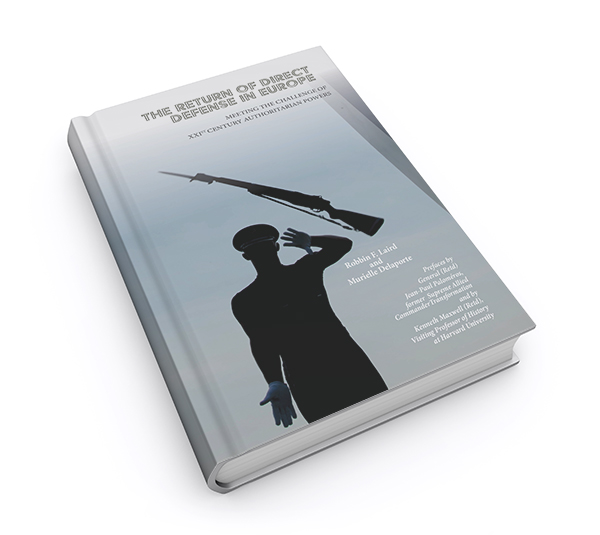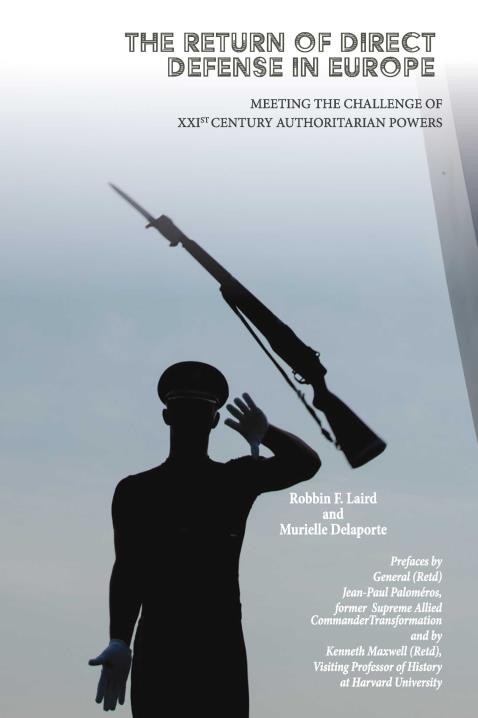
We are offering a 10% discount on both the published and e-book versions of our book for the next 90 days.
That discount is taken off when you are in the shopping cart when you purchase from our website.
The coupon code for the e-book is: HJ4PKK
The coupon code for the paperback is: WLNK38
The Return of Direct Defense in Europe: Meeting the 21st Century Authoritarian Challenge focuses on how the liberal democracies are addressing the challenges of the 21st century authoritarian powers, in terms of their evolving approaches and capabilities to deal with their direct defense.
As General (Rtd.) Jean-Paul Paloméros, former NATO Commander and head of the Allied Transformation Command put it with regard to the book:
“One of the many great values of The Return of Direct Defense in Europe is that (it addresses directly the need) to meet the challenge of XXIst century authoritarian powers. Because the great risks that lie in front of our democracies deserve to be named: national selfishness, divergence of strategic and economic interests, trampling on fundamental and commonly agreed values.
“The Return of Direct Defense in Europe is both a moving testimony to those who have built and defended our democracies for seven decades but as well a vibrant appeal to resurrect the spirit and the will of the democratic Alliance’s founding fathers.
“It’s true that the future is unpredictable, but nevertheless, it’s our permanent duty to prepare for it and to learn from our history: as the Spanish-born U.S. philosopher George Santayana (1863-1952) put it: “those who cannot remember the past are condemned to repeat it.”
“In writing this outstanding tribute to democracies and the crucial need to keep on fighting for their values, Robbin Laird and Murielle Delaporte do not only draw a very well informed and instructive historic perspective on the defense of Europe since the Second World War.
“They enlighten as well with regard to the crucial challenges of the present and even more of the future, with regard to the key choices that leaders of our democracies must make, and with regard to the key question that lies in front of new generations: How best to defend together democracy as a unique heritage built upon the sacrifices of their fathers?”
Professor Kenneth Maxwell underscored:
“This is a fascinating and very timely account of the major shifts and challenges which have transformed post–Cold War Europe and outlines in troubling detail the formidable challenges which lie ahead in the post-COVID-19 pandemic world.
“It is essential reading for all those who forget that history must inform the present.
“It illustrates the need for a hard-headed evaluation of the continuities as well as the ruptures of the recent past which has transformed both the scope of North Atlantic Treaty Organization (NATO) and the European Community, and which has also created opportunities for enemies of democratic government to thrive in a resurgent Russia under the leadership of Vladimir Putin.
“These challenges will not go away any time soon.”
The book can be bought through our website:
There are a number of other booksellers worldwide from which one can purchase the book as well: Barnes and Noble, SCRIBD, KOBO, ESENTRAL, and CIANDO.
You can read additional reviews of the book here:
And here is a recent review of the European book by the author of the Second Nuclear Age.
Two key things make this an important book for academics, engineers, and defense analysts. First, the author’s method was to visit everyone who had anything to do with the F-35 and put together an overall story about this cutting-edge technology. This approach contrasts sharply with the far more common approach of a top-down descriptions. Many of these top-down approaches really offer a particular view of what the US should be doing – they offer a future “history by design” and analyze how a particular technology, here the F-35, fits into the offered view. The biases in such an approach are clear. If the particular technology fits in with the proposed future, the analyst likes the system. Otherwise not.
This top down approach has another flaw. It overlooks the innovations and insights of the designers and operators. Many recent B-School studies show that one of the best paths for successful technology innovation is what is called “Lead Users.” The idea is that most successful innovations are greatly improved by the people who actually use it. Robbin Laird effectively uses this approach to analyze how the F-35 could be a critical element in transforming warfare. No other book or report that I know of does this, or captures the many insights of users whose ideas might otherwise not be considered. He has performed a real service in this respect.
The other contribution of this book is the description of the international consortium that built it. The F-35 is the most international airplane ever built. The way this was done shows cutting edge approaches for many systems to follow.
Paul Bracken
Professor of Management and Political Science
Yale University
And for our latest book, see the following:


